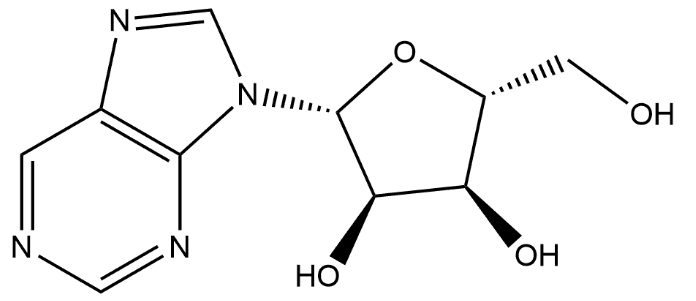
IdentificationPhysical DataSpectraRoute of Synthesis (ROS)Safety and HazardsOther Data
Identification
Product NamePurine-Nucleoside Phosphorylase (PNP)IUPAC Name1,5-dihydropyrazolopyrimidin-4-oneMolecular StructureCAS Registry Number 9030-21-1EINECS Number232-857-3MDL NumberMFCD00131739Synonymsallopurinol315-30-01H-Pyrazolopyrimidin-4-olZyloprimLopurinZyloricSuspendolAtisurilBleminolCaplenalTakanaruminUripurinolEmbarinFoliganMiluritProgoutUrosinAnoprolinCellidrinEpidropalAiluralAllopurAlluralAlositolBloxanthCosuricHamarinLedopurLysuronUricemilUriprimXanturatAloralAnziefApurinApurolGeapurGotaxRemidUrbolUrolitUrtias4-HydroxypyrazolopyrimidineKetobun-AApulongaDabrosinDabrosonKetanriftMiniplanorNektrohanAdenockAllozymAlulineGichtexMonarchRiball1H-Pyrazolopyrimidin-4(5H)-oneAllopurinolum4-HPPHexanuretEpuricAllo-PurenAllopurinol(I)Dura Al1H-Pyrazolo(3,4-d)pyrimidin-4-ol4-HydroxypyrazolopyrimidineAlopurinol180749-06-84-Hydroxy-1H-pyrazolo(3,4-d)pyrimidine73334-58-44-Hydroxy-3,4-pyrazolopyrimidineUrtias 1001H-pyrazolopyrimidin-4(7H)-one180749-08-04-Hydroxypyrazolo(3,4-d)pyrimidineSigapurolAloprimUritasNSC-1390Alopurinol 2H-Pyrazolopyrimidin-4-olAllopurinolum 4-Hydroxypyrazolyl(3,4-d)pyrimidine1H-pyrazolopyrimidin-4(2H)-one4H-Pyrazolo(3,4-d)pyrimidin-4-one4'-Hydroxypyrazolol(3,4-d)pyrimidineBW 56-158AL-1001,5-Dihydro-4H-pyrazolopyrimidin-4-one1,5-Dihydro-4H-pyrazolo(3,4-d)pyrimidin-4-oneBW-56-158180749-09-1Zyloprim (TN)1,5-Dihydro-4H-pyrazolo(3,4-d)pyrimidine-4-one916980-04-6B. W. 56-158CHEBI:402794H-Pyrazolo(3,4-d)pyrimidin-4-one, 1,5-dihydro-4H-Pyrazolopyrimidin-4-one, 1,5-dihydro-1,5-Dihydropyrazolopyrimidin-4-one1H,4H,7H-pyrazolopyrimidin-4-one63CZ7GJN5IMFCD00599413NSC-101655MLS000069453180749-07-9184789-03-59002-17-9DTXSID4022573NSC13901H,2H,4H-pyrazolopyrimidin-4-oneNSC1016554H-Pyrazolopyrimidin-4-one, 1,2-dihydro-SMR0000590834-Hydroxy-1H-pyrazolopyrimidineDTXCID5025731H-Pyrazolopyrimidin-4-ol (9CI)4H-Pyrazolopyrimidin-4-one, 1,7-dihydro- (9CI)Xanthine oxidaseDUZALLO COMPONENT ALLOPURINOLHexanuratNCGC00015094-02NCGC00094580-044H-Pyrazolopyrimidin-4-one, 2,5-dihydro- (9CI)4H-Pyrazolopyrimidin-4-one, 2,7-dihydro- (9CI)BW-561581H,4H,5H-pyrazolopyrimidin-4-one1,5-Dihydro-pyrazolopyrimidin-4-oneALLOPURINOL (MART.)ALLOPURINOL ALLOPURINOL (USP-RS)ALLOPURINOL BW 56158ALLOPURINOL (EP IMPURITY)ALLOPURINOL 4H-PyrazoloWLN: T56 BMN GN INJ FQALLOPURINOL (USP MONOGRAPH)ALLOPURINOL 4-Hydroxypyrazolylpyrimidine4'-HydroxypyrazololpyrimidineNSC 1390CAS-315-30-0CCRIS 626NSC 101655HSDB 3004SR-05000001983EINECS 206-250-9UNII-63CZ7GJN5IallopurinoloZurinolUrictoATH0084-HydroxypyrazolpyrimidinePrestwick_511Xanthomax-100Xanthomax-300Aluline 100Aluline 300Hamarin 100Hamarin 300Zyloric-300Allopurinol Allopurinol (Zyloprim)Spectrum_000026ALLOPURINOL Opera_ID_1680Spectrum2_000098Spectrum3_000289Spectrum4_000135Spectrum5_000768ALLOPURINOL ALLOPURINOL Lopac-A-80031,4-d]pyrimidin-4-oneALLOPURINOL ALLOPURINOL A 8003cid_2094SCHEMBL4627CHEMBL1467NCIOpen2_001825Lopac0_000102ALLOPURINOL ALLOPURINOL BSPBio_001798KBioGR_000550KBioSS_000386MLS001148183US9138393, AllopurinolUS9144538, AllopurinolDivK1c_000685SPECTRUM1500108SPBio_000056ALLOPURINOLUM 4'-HPPGTPL6795SCHEMBL1128219Allopurinol (JP17/USP/INN)BDBM35440HMS502C07KBio1_000685KBio2_000386KBio2_002954KBio2_005522KBio3_001298ALLOPURINOL M04AA01NINDS_000685BDBM181133HMS1920A15HMS2091G15HMS2234M09HMS3259K13HMS3260E06HMS3371I11HMS3651O13HMS3714L22Pharmakon1600-01500108AMY18272BCP26973HY-B0219STR05189Tox21_110082Tox21_200922Tox21_5001024-Hydroxy-pyrazolopyrimidinAC-019BDBM50016784BDBM50140241CCG-38916NSC755858s1630SC1118SC2251AKOS000267490AKOS000269759AKOS024255717Tox21_110082_1Allopurinol, xanthine oxidase inhibitorCCG-204197CCG-221406CCG-266128DB00437LP00102NC00492NSC-755858SB10164SDCCGSBI-0050090.P005IDI1_000685NCGC00015094-01NCGC00015094-03NCGC00015094-04NCGC00015094-05NCGC00015094-06NCGC00015094-07NCGC00015094-08NCGC00015094-18NCGC00015094-22NCGC00091134-01NCGC00091134-02NCGC00091134-03NCGC00094580-01NCGC00094580-02NCGC00094580-05NCGC00188948-01NCGC00258476-01NCGC00260787-01TS-00028SBI-0050090.P0041H-PYRAZOLO(3,4-D)PYRIMDIN-4-OL2H-Pyrazolopyrimidin-4-ol (9CI)A0907EU-0100102NS00000618SW199406-41,5-dihydropyrazolo-pyrimidin-4-oneEN300-34144VU0611037-1BIM-0061756.0001D00224F18007AB00173448-03AB00173448-04AB00173448_05AB01274719-01AB01274719_021,5-Dihydro-4H-pyrazolo(3,4-d)pryimidin-4-oneAB-323/25048497Allopurinol (4-Hydroxypyrazolopyrimidine)Q412486SR-010000755954H-pyrazolopyrimidin-4-one, 1,7-dihydro-J-504736SR-01000075595-1SR-05000001983-1SR-05000001983-2W-106892F2173-0394F3329-0375Molecular FormulaC5H4N4OMolecular Weight136.11InChIInChI=1S/C5H4N4O/c10-5-3-1-8-9-4(3)6-2-7-5/h1-2H,(H2,6,7,8,9,10)InChI KeyCUYKNJBYIJFOFCNXPDARWKPPY-UHFFFAOYSA-N Isomeric SMILESC1=NNC2=C1C(=O)NC=N2
Physical Data
AppearanceWhite amorphous powder
Spectra
No data available
Route of Synthesis (ROS)
No data available
Safety and Hazards
Pictogram(s)SignalDangerGHS Hazard StatementsH301 (53.15%): Toxic if swallowed H317 (94.41%): May cause an allergic skin reaction Precautionary Statement CodesP261, P264, P270, P272, P280, P301+P316, P302+P352, P321, P330, P333+P317, P362+P364, P405, and P501(The corresponding statement to each P-code can be found at the GHS Classification page.)
Other Data
HS CodeStorageStore at -20°C for long time, sealed and away from light.Shelf Life2 yearsMarket Price
Use PatternPurine-Nucleoside Phosphorylase (PNP) CAS#: 9030-21-1 a type of enzyme, is primarily involved in the metabolism of purine nucleotides. Its main function is to catalyze the transfer of a phosphate group between two adenylic acid (adenylate) molecules, forming an adenylic acid and an adenosine diphosphate (ADP) molecule. And Purine-Nucleoside Phosphorylase (PNP) functions in various cellular processes, including energy transfer, purine metabolism, and signal transduction. These functions are essential for maintaining normal cellular physiology and adapting to changes in the cellular environment.
https://www.chemwhat.com/purine-nucleoside-phosphorylase-pnp-cas-9030-21-1/
Comments
Post a Comment